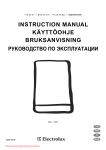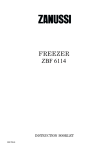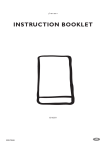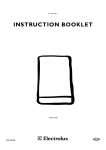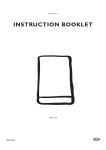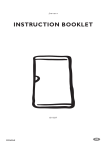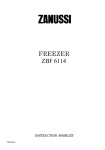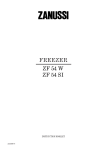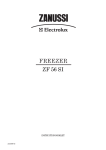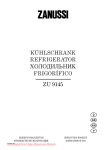Download Electrolux EUN 12300 Instruction manual
Transcript
Gefrierschrank / freezer GEBRAUCHSANWEISUNGEN INSTRUCTION MANUAL EUN 12300 D 2222 724-91 GB CONTENTS Instructions for the Installer Instructions for the User Important Safety Instructions 14 Technical specifications 20 Use 16 Installation 20 Cleaning the interior Control panel Operation Temperature regulation Quick freezing Warning light Acoustic alarm Freezing calendar Freezing of fresh foods Storage of commercially frozen food Thawing Ice-cube production Tips Tips for freezing fresh foods Tips for storage of commercially frozen food Maintenance Periodic cleaning Periodios of non-operation Defrosting Something not Working Positioning Electrical connection Door reversal Instructions for totally built-in appliances 16 16 16 16 17 17 17 17 17 17 17 17 18 18 18 18 18 18 18 19 13 20 20 20 21 IMPORTANT SAFETY INSTRUCTIONS It is most important that this instruction book should be retained with the appliance for future reference. Should the appliance be sold or transferred to another owner, or should you move house and leave the appliance, always ensure that the book is supplied with the appliance in order that the new owner can be acquainted with the functioning of the appliance and the relevant warnings. These warnings are provided in the interest of safety. You must read them carefully before installing or using the appliance. General Safety ■ ■ ■ ■ ■ ■ ■ ■ ■ ■ ■ This appliance is designed to be operated by adults. Children should not be allowed to tamper with the controls or play with the product. It is dangerous to alter the specifications or modify this product in any way. Before any cleaning or maintenance work is carried out, be sure to switch off and unplug the appliance. This appliance is heavy. Care should be taken when moving it. Ice follies can cause frost burns if consumed straight from the appliance. Take utmost care when handling your appliance so as not to cause any damages to the cooling unit with consequent possible fluid leakages. The appliance must not be located close to radiators or gas cookers. Avoid prolonged exposure of the appliance to direct sunlight. There must be adequate ventilation round the back of the appliance and any damage to the refrigerant circuit must be avoided. For freezers only (except built-in models): an ideal location is the cellar or basement. Do not use other electrical appliances (such as ice cream makers) inside of refrigerating appliances. ■ Use ■ ■ ■ ■ ■ Service / Repair ■ ■ ■ Any electrical work required to install this appliance should be carried out by a qualified electrician or competent person. This appliance should be serviced by an authorised Service Centre, and only genuine spare parts should be used. Under no circumstances should you attempt to repair the appliance yourself. Repairs carried out by inexperienced persons may cause injury or more serious malfunctioning. Refer to your local Service Centre, and always insist on genuine spare parts. This appliance contains hydrocarbons in its cooling unit; maintenance and recharging must therefore only be carried out by authorised technicians. The domestic refrigerators and freezers are designed to be used specifically for the storage of edible foodstuffs only. Frozen food must not be re-frozen once it has been thawed out. Manufacturers’ storage recommendations should be strictly adhered to. Refer to relevant instructions. The inner lining of the appliance consists of channels through which the refrigerant passes. If these should be punctured this would damage the appliance beyond repair and cause food loss. DO NOT USE SHARP INSTRUMENTS to scrape off frost or ice. Frost may be removed by using the scraper provided. Under no circumstances should solid ice be forced off the liner. Solid ice should be allowed to thaw when defrosting the appliance. See defrost instructions. Do not place carbonated or fizzy drinks in the freezer as it creates pressure on the container, which may cause it to explode, resulting in damage to the appliance. Do not use a mechanical device or any artificial means to speed up the thawing process other than those recommended by the manufacturer. Never use metal objects for cleaning your appliance as it may get damaged. Installation ■ ■ Care must be taken to ensure that the appliance does not stand on the electrical supply cable. Important: if the supply cable is damaged, it must be replaced by authorised service or qualified personnel using a special cable of the same type. During normal operation, the condenser and compressor at the back of the appliance heat up considerably. For safety reasons, minimum ventilation must be as shown in the relevant paragraph. 14 ■ ■ ■ ■ Attention: keep ventilation openings clear of obstruction. If the appliance is transported horizontally, it is possible that the oil contained in the compressor flows in the refrigerant circuit. It is advisable to wait at least two hours before connecting the appliance to allow the oil to flow back in the compressor. There are working parts in this product which heat up. Always ensure that there is adequate ventilation as a failure to do this will result in component failure and possible food loss. See installation instructions. Parts which heat up should not be exposed. Wherever possible the back of the product should be against a wall. If the appliance has been transported horizontally, it is possible that the oil contained in the compressor flows in the refrigerant circuit. It is advisable to wait at least two hours before connecting the appliance to allow the oil to flow back in the compressor. Environment Protection ■ This appliance does not contain gasses which could damage the ozone layer, in either its refrigerant circuit or insulation materials. The appliance shall not be discarded together with the urban refuse and rubbish. Avoid damaging the cooling unit, especially at the rear near the heat exchanger. Information on your local disposal sites may be obtained from your municipal authorities. ■ The materials used on this appliance marked with the symbol are recyclable. Disposal of old appliances The symbol on the product or on its packaging indicates that this product may not be treated as household waste. Instead it shall be handed over to the applicable collection point for the recycling of electrical and electronic equipment. By ensuring this product is disposed of correctly, you will help prevent potential negative consequences for the environment and human health, which could otherwise be caused by inappropriate waste handling of this product. For more detailed information about recycling of this product, please contact your local city office, your household waste disposal service or the shop where you purchased the product. 15 USE The freezer is marked with the symbol, which means that the compartment is suitable for freezing fresie food and long-term storage of frozen food. Cleaning the interior Before using the appliance for the first time, wash the interior and all internal accessories with lukewarm water and some neutral soap so as to remove the typical smell of a brand-new product, then dry thoroughly. Do not use detergents or abrasive powders, as these will damage the finish. Control panel min MAX ➀ ➁ ➂ ➃ ➄ ➀ ➁ ➂ ➃ ➄ Pilot light (green) Thermostat control knob Fast freeze light (yellow) Fast freeze switch and for stopping the acoustic alarm (warning light on) Warning light (red) Operation Temperature regulation Insert the plug into the wall socket. Turn knob ➁.beyond the «0» position. Turn the thermostat knob ➁ clockwise after the position «0». The pilot light ➀ will light up and a sound is on only for 2 sec., indicating that the appliance is powered. The warning light ➄ will blink and the sound signal alarm will get on, indicating that the temperature inside the appliance is too high. To safely store frozen and deep-frozen foods, the inner temperature of the freezer must be at least -18° C or colder. Therefore, we suggest you turn the knob to a medium setting. The temperature inside the freezer is automatically adjusted to ensure safe storage of the food. Push the button ➃, the sound signal alarm will get off and pushing the button a second time the super control light ➂ light up. The freezer will start to operate. However, the exact setting should be chosen keeping in mind that the temperature inside the appliance depends on: • room temperature; • how often the door is opened; • the quantity of food stored; • location of appliance. Turn knob ➁ towards “6” to obtain lower To stop operation, simply turn the thermostat knob to position «0» and a sound is on only for 2 sec . temperatures and, conversely, towards “1” if a less cold temperature is required. 16 Quick freezing In the top compartment, products must only be stacked up to the mark on the cabinet wall so as to ensure that air circulation is not obstructed. The maximum amount of food which is freezable in 24 hours is indicated on the rating plate. This is to be found on the bottom left-hand side. You should never freeze all at once a greater quantity of foods than the maximum indicated on the appliance’s rating plate. For quick-freezing, push the button ➃. The super control light ➂ will then light up. If the quick-freezing function is not ended manually, the appliance switch off the quick-freezing function after 52 hours. The yellow light goes out. The quick-freezing function can be ended manually at any time by pressing the button ➃ again. The yellow light goes out. Storage of frozen food When you first start the freezer or if the freezer has been out of use for some time, we advise you to run your appliance for at least two hours in the «fast freeze» mode before storing frozen food. Warning light This light ➄ flashes when the temperature inside the appliance has increased so much as to jeopardize the preservation of food in the compartment (warmer than -12°C). When the appliance is switched on for the first time or when food is placed in the compartment for freezing, this light flashes until the temperature has reached the level required for correct storage. Important If there is a power failure when food is in the freezer, do not open the door of the freezer. The frozen food will not be affected if the power cut is of short duration (up to 20 hours) and the freezer is full, otherwise, it is recommended that the food should be used within a short time (a temperature increase of the frozen food shortens its safe storage period). Sound signal alarm This appliance incorporates an alarm which gives off a sound signal when the temperature inside the freezer has risen to a point where the safe storage of frozen food is no longer ensured. This sound can be turned off pushing the button ➃ To remove the drawers, proceed as follows: pull the drawer out until it comes to a stop, then tilt it upwards (see figure). Freezing Calendar The symbols on the drawers show different types of frozen goods. 1-2 3-4 3-6 3-6 3-6 3-6 10 -12 10 -12 10 -12 10 -12 The numbers indicate storage times in months for the appropriate types of frozen goods. Whether the upper or lower value of the indicated storage time is valid depends on the quality of the foods and pre-treating before freezing. PR001c Freezing of fresh foods Thawing To quick-freeze foods when the appliance has not been in use, switch on the freezer and let it run on the quick-freeze setting for at least three hours before putting the food to be frozen in the compartment. If instead the appliance is already in operation, it should run on the quick-freeze setting for at least 24 hours before the foods are put in the freezer. Once the foods have been placed in the freezer, the freezing operation can be considered to be complete 24 hours later. Once freezing is complete, the freezer should be reset for normal storage use. Food to be frozen has to be placed in the appliance's two top compartments; if freezing only a small amount of food, use the top compartment. Deep-frozen or frozen food, prior to being used, can be thawed in the refrigerator or at room temperature, depending on the time available for this operation. Small pieces may even be cooked still frozen, directly from the freezer: in this case, cooking will take longer. Ice-cube production This appliance is equipped with one or more trays for the production of ice-cubes. Fill these trays with water, then put them in the freezer. Do not use metallic instruments to remove the trays from the freezer. 17 TIPS Tips for freezing fresh foods ■ To help you get the best out of the freezing process, here are a few hints: ■ Freeze only good-quality, fresh and well-cleaned foods. Split them into small portions to speed up freezing and avoid having to thaw more food than you require. It is in fact important to remember that once the foods have thawed out, they deteriorate fast. ■ Another point to remember is that lean foods keep better and longer than fatty foods. Salt too reduces storage times. ■ Wrap the foods in foil or polythene ½lm, ensuring that the wrapping adheres closely to the food and is well sealed. In this way, by avoiding contact with air, the colour ¾avour and nutritional value of the foods remain intact. ■ During the freezing process, do not add further foods for freezing and do not open the freezer door. ■ The foods for freezing should not be placed in contact with already frozen foods, but put in the special freezing compartment. This will stop the temperature of already frozen foods from rising. ■ Never put ½zzy drinks in the freezer as they might well burst. ■ In addition, never put hot foods or liquids in the freezer compartment and take care not to ½ll recipients up to the brim if they are covered with a lid. It is a good idea to mark the packs with the date on which freezing started so that you can keep a check on storage periods. Tips for storage of commercially frozen food To get the best out of your freezer, in the case of storage of commercially frozen food you should ensure that: ■ the products have been correctly stored by the retailer; ■ that there is only a very short time between when you purchase the products and when you put them in the freezer; ■ you do not store products for longer than the time speci½ed by the food manufacturer; ■ Avoid opening the door too frequently and when you do open it, leave it open only for as long as is strictly necessary; ■ A word of warning about ice lollies: they should not be eaten straight out of the freezer as this might cause cold burns. MAINTENANCE Periods of non-operation Unplug the appliance before carrying out any maintenance operation. When the appliance is not in use for long periods, take the following precautions: remove the plug from the wall socket; remove all food: defrost and clean the interior and all accessories; leave the door ajar to allow air to circulate to prevent unpleasant smells. Warning This appliance contains hydrocarbons in its cooling unit maintenance and recharging must therefore only be carried out by authorised technicians. Periodic cleaning Never use metal objects for clearing your appliance as it may get damaged. Clean the inside with warm water and bicarbonate of soda. Rinse and dry thoroughly. To guarantee a safe operation of the fridge, once a year remove the ventilation grille at the base and clean the air channels with a vacuum cleaner. 18 Defrosting The freezer compartment will become progressively covered with frost. This should be removed with the special plastic scraper provided, whenever the thickness of the frost exceeds 1/4". During this operation it is not necessary to switch off the power supply or to remove the foodstuffs. However, when the ice becomes very thick on the inner liner, complete defrosting should be carried out and it is advisable to carry out this operation when the appliance is empty. To carry out complete defrosting proceed as follows: 1. Remove any stored food, wrap it in several layers of newspaper and put it in a cool place. 2. Turn the thermostat control knob ➁ to the «■» setting. 3. Leave the door open. 4. Introduce the plastic scraper in the appropriate seating at the base of the cabinet as shown in the figure and place a basin underneath to collect the defrost water (see fig.). 5. When defrosting is completed dry the interior thoroughly. Keep the scraper for future use. 6. Turn the thermostat control to a medium setting and, after letting the appliance run for at least two hours in the «fast freeze» mode, replace the previously removed food into the compartments. D068 Warning Never use metal objects for defrosting your appliance as it may get damaged. Do not use a mechanical device or any artificial means to speed up the thawing process other than those recommended by the manufacturer. A temperature increase of the frozen food shortens its safe storage period. SOMETHING NOT WORKING If the appliance is not functioning properly, check that: Malfunction Remedy Appliance does not function, no pilot light is illuminated. - Appliance is not switched on; switch appliance on. - Mains plug is not inserted or is loose; insert mains plug. - Fuse has blown or is defective; check fuse, replace if necessary. - Mains socket is defective; Mains malfunctions are to be corrected by an electrician. The freezer temperature is not sufficient, red light lights up. - Temperature is not properly adjusted; please refer to the section “Temperature regulation”. - Door was open for a long time; only leave the door open as long as necessary. - Within the last 24 hours a large quantity of warm foods were loaded; press the fast freeze button. - Appliance is next to a source of warmth; please refer to the section “Location”. Large accumulation of frost in the appliance, perhaps also at the door seal. - Door is not properly sealed (perhaps after re-hanging door); carefully warm the door seal with a hand-held hair dryer at those points which are not airtight (no warmer than approx. 50°C). At the same time, shape the warmed door seal by hand, so that it is again properly seated. Unusual noises. - A part at the back of the appliance, e.g. a tube, is in contact with another appliance part or the wall; bend this part away carefully if necessary. The compressor does not start immediately after pressing the fast freeze button or after changing the temperature setting. - This is normal, no error has occurred; the compressor starts after a period of time. The appliance works, but the pilot light is flashing Please contact the nearest service centre. 19 If your appliance is still not working properly after making the above checks, contact the nearest service centre. To obtain fast service, it is essential that when you apply for it you specify the model and serial number of your appliance which can be found on the guarantee certificate or on the rating plate located inside the appliance, on the bottom left-hand side. TECHNICAL INFORMATION The technical infomation are situated in the rating plate on the internal left side of the appliance . INSTALLATION lf this appliance featuring magnetic door seals is to replace an older appliance having a spring lock (latch) on the door or lid, be sure to make that spring lock unusable before you discard the old appliance. This will prevent it from becoming a death-trap for a child. Attention! It must be possible to disconnect the appliance from the mains power supply; the plug must therefore be easily accessible after installation. This appliance complies with the following E.E.C. Directives: - 87/308 EEC of 2/6/87 relative to radio interference suppression. - 73/23 EEC of 19.2.73 (Low Voltage Directive) and subsequent modifications; - 89/336 EEC of 3.5.89 (Electromagnetic Compatibility Directive) and subsequent modifications. Positioning The appliance should be installed well away from sources of heat such as radiators, boilers, direct sunlight etc. Best performance is obtained with ambient temperature between +18°C and +43°C (class T); +18°C and +38°C (class ST); +16°C and +32°C (class N); +10°C and +32°C (class SN). The class of your appliance is shown on its rating plate. For building-in and door reversibility refer to the relevant instructions. Door reversal The appliance’s door has been locked in position for transport by means of pins on both sides. According to the door opening direction, remove relevant pins at the top and at the bottom. Electrical connection A Before plugging in, ensure that the voltage and frequency shown on the serial number plate correspond to your domestic power supply. Voltage can vary by ±6% of the rated voltage. For operation with different voltages, a suitably sized auto-transformer must be used. Important The appliance must be earthed. The power supply cable plug is provided with a contact for this purpose. If the domestic power supply socket is not earthed. connect the appliance to a separate earth in compliance with current regulations, consulting a specialist technician. The Manufacturer declines all responsibility if the above safety precautions are not observed. B Warning! If the ambient temperature is cold (i.e. in Winter), the gasket may not fit perfectly to the cabinet. In that case, wait for the natural fitting of the gasket or accelerate this process by heating up the part involved with a normal hairdrier. 20 Instructions for totally built-in appliances Dimensions of the recess Height of housing Depth of housing Width of housing mm 880 mm 550 mm 560 50 540 D132 2. Apply joint the sealing strip as shown in figure. 0 56 55 0 880 PR 32 It is necessary that the niche is provided with a conduct of ventilation having the following dimensions: Depth 50 mm Width 540 mm 50 mm min. 200 cm 2 I min. 200 cm 3. Open the door and push the appliance against the side of the kitchen unit opposite to that of appliance hinges. Fasten the appliance with 4 screws (I) provided in the kit included with the appliance. 2 D526 For safety reasons, minimum ventilation must be as shown in Fig. Attention: keep ventilation openings clear of obstruction. D C 1 E B 2 4. Snap vent grille (B) and hinge cover (E) into position. Apply covers (C-D) on joint cover lugs and into hinge holes. D022 1. Fit the appliance in the niche by making sure that it stands against the interior surface of the unit on the side where the door hinges of the appliances are fitted. Insert the appliance until the upper strip butts up against the unit (1) and make sure that the lower hinge is in line with the surface of the unit (2). 21 8mm Hb Ha Hc Ha Hd PR266 PR167 5. Separate parts Ha, Hb, Hc, Hd as shown in the figure. Hb 8. Open the appliance door and the furniture door at 90°. Insert the small square (Hb) into guide (Ha). Put together the appliance door and the furniture door and mark the holes as indicated in the figure. ca. 50 mm 90° 8mm 21 m m 90° K ca. 50 mm 21 m m Ha 6. Place guide on the inside part of the furniture door, up and down as shown in the figure and mark the position of external holes. After having drilled holes, fix the guide with the screws supplied. PR167 9. Remove the brackets and mark a distance of 8 mm from the outer edge of the door where the nail must be fitted (K). Ha Hc Hb PR33 PR168 7. Fix cover (Hc) on guide (Ha) until it clips into place. 10. Place the small square on the guide again and fix it with the screws supplied. Should the lining up of the furniture door be necessary, use the clearance of slots. At the end of operations, it is necessary to check if the door of the furniture closes properly. 22 Hb Hd PR167/1 11. Fix cover (Hd) on the small square (Hb) until it clips into place. 23 ELECTROLUX HOME PRODUCTS OPERATIONS EUROPE













